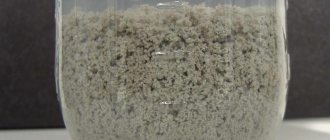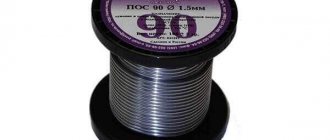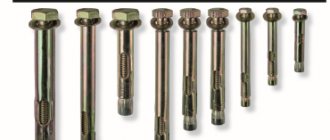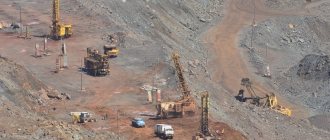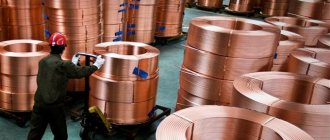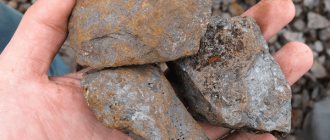Brief Description of Iron Ore
Editorial
Promdevelop editorial team
Iron ore is the main raw material for the global metallurgical industry.
- Open pit ore mining
- Countries rich in ores
The economies of different countries largely depend on the market for this mineral, which is why the development of mines is receiving increased attention all over the world.
Ore: definition and features
Ores are rocks that are used for processing and extracting the metals they contain. The types of these minerals differ in origin, chemical content, concentration of metals and impurities. The chemical composition of the ore contains various oxides, hydroxides and carbon dioxide salts of iron.
Interesting! Ore has been in demand on the farm since ancient times. Archaeologists were able to find out that the manufacture of the first iron objects dates back to the 2nd century. BC. This material was first used by the inhabitants of Mesopotamia.
Chemical composition
The properties of iron ore, its value and characteristics directly depend on its chemical composition. Iron ore may contain varying amounts of iron and other impurities. Depending on this, there are several types:
- very rich, when the iron content in the ores exceeds 65%;
- rich, the percentage of iron in which varies from 60% to 65%;
- average, from 45% and above;
- poor, in which the percentage of useful elements does not exceed 45%.
Read also: Brush attachment for an angle grinder
The more by-products there are in iron ore, the more energy is needed to process it, and the less efficient the production of finished products is.
The composition of a rock can be a combination of various minerals, waste rock and other by-products, the ratio of which depends on its deposit.
Gap rock may also contain iron, but recycling it is not economically feasible. The most commonly found minerals are iron oxides, carbonates and silicates.
It should be noted that ferruginous rocks may contain a huge amount of harmful substances, among which are sulfur, arsenic, phosphorus and others.
Ore properties
Iron is a common chemical element in nature. Its content in the earth's crust is about 4.2%. But in its pure form it is almost never found, most often in the form of compounds - in oxides, iron carbonates, salts, etc. Iron ore is a combination of minerals with a significant amount of iron. In the national economy, the use of ores containing more than 55% of this element is considered economically feasible.
What is made from ore
The iron ore industry is a metallurgical industry that specializes in the extraction and processing of iron ore. The main purpose of this material today is the production of cast iron and steel.
All products made from iron can be divided into groups:
- Pig iron with high carbon concentration (above 2%).
- Cast iron.
- Steel ingots for the production of rolled products, reinforced concrete and steel pipes.
- Ferroalloys for steel smelting.
What is ore needed for?
The material is used for smelting iron and steel. Today there is practically no industrial sector that can do without these materials.
Everything about gold mining. Where and how is gold mined?
Cast iron is an alloy of carbon and iron with manganese, sulfur, silicon and phosphorus. Pig iron is produced in blast furnaces, where the ore is separated from iron oxides at high temperatures. Almost 90% of the resulting cast iron is marginal and is used in steel smelting.
Various technologies are used:
- electron beam melting to obtain pure high-quality material;
- vacuum processing;
- electro-slag remelting;
- steel refining (removal of harmful impurities).
The difference between steel and cast iron is the minimum concentration of impurities. Oxidative smelting in open-hearth furnaces is used for purification.
The highest quality steel is smelted in electric induction furnaces at extremely high temperatures.
Nickel ores
What are nickel ores? The mineral formations that are used for the industrial production of this metal are called nickel ores. There are sulfide copper-nickel ores with a pure metal content of up to four percent and silicate nickel ores, the same figure being up to 2.9%. The first type of deposits is usually of the igneous type, and silicate ores are found in areas of the weathering crust.
The development of the nickel industry in Russia is associated with the development of their location in the Middle Urals in the mid-19th century. Almost 85% of sulfide deposits are concentrated in the Norilsk region. The deposits in Taimyr are the largest and most unique in the world in terms of the wealth of reserves and diversity of minerals; they contain 56 elements of the periodic table. The quality of nickel ores in Russia is not inferior to other countries; the advantage is that they contain additional rare elements.
About ten percent of nickel resources are concentrated in sulfide deposits on the Kola Peninsula, and silicate deposits are being developed in the Middle and Southern Urals.
The ores of Russia are characterized by the quantity and variety necessary for industrial use. However, at the same time, they are distinguished by difficult natural production conditions, uneven distribution across the country, and a discrepancy between the region where resources are located and the population density.
What types of ores are there?
Ore differs in the concentration of the element it contains. It can be enriched (with a concentration of 55%) and poor (from 26%). It is advisable to use low-grade ores in production only after enrichment.
Based on their origin, the following types of ores are distinguished:
- Magmatogenous (endogenous) - formed under the influence of high temperature;
- Surface - settled remains of the element on the bottom of sea basins;
- Metamorphogenic - obtained under the influence of extremely high pressure.
Main mineral compounds containing iron:
- Hematite (red iron ore). The most valuable source of iron with an element content of 70% and a minimum concentration of harmful impurities.
- Magnetite. A chemical element with a metal content of 72% is distinguished by high magnetic properties and is mined from magnetic iron ores.
- Siderite (iron carbonate). There is a high content of waste rock, the iron itself is about 45-48%.
- Brown iron ores. A group of aqueous oxides with a low percentage of iron, with admixtures of manganese and phosphorus. An element with such properties is characterized by good recoverability and porous structure.
Origin of iron ore
All currently known types of ores were formed in three ways:
Igneous
Such ores were formed as a result of exposure to high temperatures of magma or ancient volcanic activity, that is, the melting and mixing of other rocks. Such minerals are hard crystalline minerals with a high percentage of iron. Ore deposits of igneous origin are usually associated with old mountain-building zones, where the molten substance came close to the surface.
The process of formation of igneous rocks is as follows: the melt of various minerals (magma) is a very fluid substance, and when cracks form in places of faults, it fills them, cooling and acquiring a crystalline structure. This is how layers with magma frozen in the earth's crust were formed.
Metamorphic
This is how sedimentary types of minerals are transformed. The process is as follows: when individual sections of the earth's crust move, some of its layers containing the necessary elements fall under the underlying rocks. At depth, they are susceptible to the high temperature and pressure of the upper layers. Over millions of years of such exposure, chemical reactions occur here that transform the composition of the source material and crystallize the substance. Then, during the next movement, the rocks end up closer to the surface.
Typically, iron ore of this origin does not lie too deep and has a high percentage of useful metal composition. For example, a bright example is magnetic iron ore (up to 73-75% iron).
Sedimentary
The main “workers” in the process of ore formation are water and wind. Destroying rock layers and moving them to lowlands, where they accumulate in the form of layers. Plus, water, as a reagent, can modify the source material (leach). As a result, brown iron ore is formed - crumbly and friable ore containing from 30% to 40% iron, with a large number of various impurities.
Due to various ways of formation, raw materials are often mixed in layers with clays, limestones and igneous rocks. Sometimes deposits of different origins can be mixed in one field. But most often one of the listed breed types predominates.
Having established through geological exploration an approximate picture of the processes occurring in a particular area, possible locations with iron ores are determined. Like, for example, the Kursk magnetic anomaly, or the Krivoy Rog basin, where industrially valuable types of iron ore were formed as a result of magmatic and metamorphic influences.
What does ore look like?
What does iron ore look like?
The type of material depends on its composition and the content of additional impurities. The most common red iron ore with a high percentage of iron can be found in different states - from very dense to dusty.
Brown iron ores have a loose, slightly porous structure of brown or yellowish color. Such an element often requires enrichment, but is easily processed into ore (high-quality cast iron is obtained from it).
Magnetic iron ores are dense and granular in structure, looking like crystals embedded in the rock. The color of the ore is characteristic black-blue.
How ore is mined
Iron ore mining is a complex technical process that involves diving into the depths of the earth to search for minerals. Today, there are two methods of ore mining: open and closed.
Open pit ore mining
Open-pit mining of ore
Open-pit (quarry) is a common and safest option compared to closed mining. The method is relevant for cases where there are no hard rocks in the working area, and there are no populated areas or utility systems nearby.
First, a quarry up to 350 meters deep is dug, after which iron is collected and removed from the bottom by large machines. After extraction, the material is sent on diesel locomotives to steel and iron factories.
Natural gas production in Russia: past, present, future
Quarries are dug using excavators, but this process takes a lot of time. As soon as the machine reaches the first layer of the mine, the material is submitted for examination to determine the percentage of iron content and the feasibility of further work (if the percentage is above 55%, work in this area continues).
Interesting! Compared to the closed method, mining in quarries costs half as much. This technology does not require the construction of mines or the creation of tunnels. At the same time, the efficiency of work in open pits is several times higher, and the loss of material is five times less.
Closed mining method
Closed ore mining Mine
(closed) ore mining is used only if it is planned to maintain the integrity of the landscape in the area where ore deposits are being mined. This method is also relevant for work in mountainous areas. In this case, a network of tunnels is created underground, which leads to additional costs - the construction of the mine itself and the complex transportation of metal to the surface. The main drawback is the high risk to the lives of workers; the mine can collapse and block access to the surface.
Modern production of metal from ore
The ore is a stone containing a large amount of silicates. An electromagnetic separator is used to sort out rich rocks and waste rock. To separate metal from ore, it is crushed into small pieces and treated with chemicals. This process is called enrichment.
Purification of ferrous metal ores
There are several ways to purify ore - with magnetic devices, acids, vibration, but now flotation is most often used. For this purpose, heavy liquids and suspensions are used. The vessel into which the crushed ore is placed is filled with a solution, and a high pressure of air under pressure is supplied through it, as a result of which the metal with foam rises up, and the waste rock settles to the bottom. Smelting metal from ore requires high temperatures in which small particles of rock burn.
This is the simplest and fastest way to get rich, it does not require a large number of operations, and is relatively cheap. The resulting metal particles are melted in blast furnaces or steel smelting furnaces, making blanks for further use in production.
There is also non-chemical cleaning - in vibration bins, where, with the help of high vibration frequencies, rock is destroyed, turning into sand, it spills through a sieve, and metal particles remain on the surface. But this does not always help to completely separate the rock from the iron ore, so it is combined with the chemical method.
In blast furnaces, cast iron billets are smelted for production to make steel; admixtures of other alloys and scrap metal are added to it.
Typically, factories are located in places where mineral resources are located, so as not to waste time on transportation.
Purification of non-ferrous metal ores
Non-ferrous metals are much less common in nature compared to ferrous metals. They can be divided into heavy (copper, bronze, lead, nickel, zinc, cobalt) and light (titanium, aluminum, magnesium).
One of the most common examples of minerals is aluminum. Bauxite and nepheline ores are processed to produce alumina, a white powder similar to starch. Its chemical composition is Al2O3. Pure aluminum is obtained by electrolysis, when, under the influence of a directed current, the molecule is converted into cations - Al+ and O-. They settle on oppositely charged electrodes, resulting in pure aluminum.
The metal extracted from alumina is poured into a mixer, where it is mixed with other materials to give it the desired plastic properties. Aluminum ingots are cast from the resulting composition, which are sent to various production facilities for further use.
Copper is isolated from copper sulfide concentrate mined in mines. It contains a huge amount of metals. To separate clean material, metallurgical plants use pyrotechnologies, which involve the use of high temperatures. The mechanism for obtaining copper is no different from processing black ore - the precipitation method is used - fluoridation. Subsequently, the concentrate is sent to the plant, where it is further purified from impurities. It is melted under high temperatures to produce blister copper.
Where is ore mined?
Iron ore mining is one of the leading areas of the economic complex of the Russian Federation. But despite this, Russia's share in world ore production is only 5.6%. World reserves amount to about 160 billion tons. The volume of pure iron reaches 80 billion tons.
Countries rich in ores
The distribution of minerals by country is as follows:
- Russia - 18%;
- Brazil - 18%;
- Australia - 13%;
- Ukraine - 11%;
- China - 9%;
- Canada - 8%;
- USA - 7%;
- other countries - 15%.
Significant deposits of iron ore have been noted in Sweden (the cities of Falun and Gellivar). In America, a large amount of ore was discovered in the state of Pennsylvania. In Norway, the metal is mined in Persberg and Arendali.
Ores of Russia
The Kursk magnetic anomaly is a large deposit of iron ore in the Russian Federation and in the world, in which the volume of unrefined metal reaches 30,000 million tons.
Kursk magnetic anomaly - photo from the mining site
Interesting! Analysts note that the scale of mineral production at the KMA mines will continue until 2021, and there will be a decline in the future.
The area of the Kola Peninsula mines is 115,000 sq. km. Iron, nickel, copper ores, cobalt and apatites are mined here.
The Ural Mountains are also among the largest ore deposits in the Russian Federation. The main development area is Kachkanar. The volume of ore minerals is 7000 million tons.
Russian development that makes it possible to extract gold from coal
The metal is mined in smaller quantities in the West Siberian basin, Khakassia, the Kerch basin, Zabaikalsk and the Irkutsk region.
Extraction of iron ore on an industrial scale
Humanity began to mine ore a very long time ago, but most often it was low-quality raw material with significant sulfur impurities (sedimentary rocks, the so-called “swamp” iron). The scale of development and smelting was constantly increasing. Today, a whole classification of various deposits of ferrous ores has been built.
Main types of industrial deposits
All ore deposits are divided into types depending on the origin of the rock, which in turn makes it possible to distinguish main and secondary iron ore areas.
Main types of industrial iron ore deposits
These include the following deposits:
- Deposits of various types of iron ore (ferruginous quartzites, magnetic iron ore), formed by a metamorphic method, which makes it possible to mine ores that are very rich in composition. Typically, deposits are associated with ancient processes of formation of rocks in the earth's crust and lie on formations called shields.
A crystalline shield is a formation shaped like a large curved lens. It consists of rocks formed during the formation of the earth’s crust 4.5 billion years ago.
The most famous deposits of this type are: Kursk Magnetic Anomaly, Krivoy Rog Basin, Lake Superior (USA/Canada), Hamersley Province in Australia, and the Minas Gerais iron ore region in Brazil.
- Deposits of stratified sedimentary rocks. These deposits were formed due to the sedimentation of iron-rich compounds that are present in minerals destroyed by wind and water. A striking example of iron ore in such deposits is brown iron ore.
The most famous and large deposits are the Lorraine basin in France and the Kerch basin on the peninsula of the same name (Russia).
- Skarn deposits. Usually the ore is of igneous and metamorphic origin, the layers of which, after formation, were displaced at the time of formation of the mountains. That is, iron ore, located in layers at depth, was crushed into folds and moved to the surface during the movement of lithospheric plates. Such deposits are often located in folded areas in the form of layers or pillars of irregular shape. Formed magmatically. Representatives of such deposits: Magnitogorskoye (Ural, Russia), Sarbaiskoye (Kazakhstan), Iron Springs (USA) and others.
- Titanium magnetite ore deposits. Their origin is igneous, most often found on outcrops of ancient bedrock - shields. These include basins and fields in Norway, Canada, Russia (Kachkanarskoye, Kusinskoye).
- About a hundred mineral deposits were discovered in Russia in 2021
Secondary deposits include: apatite-magnetite, magno-magnetite, siderite, ferromanganese deposits developed in Russia, European countries, Cuba and others.
